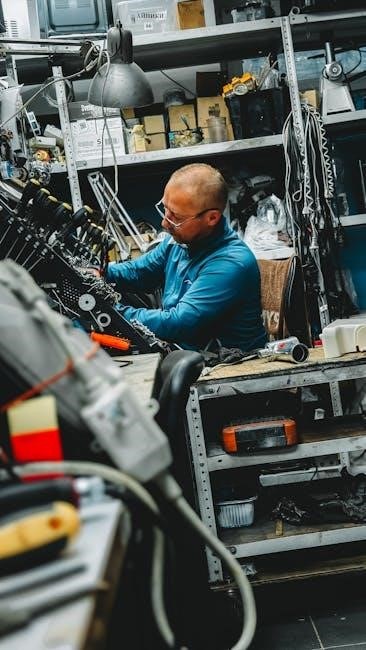Strat wiring is the backbone of your guitar’s tone and functionality. Understanding the fundamentals of Stratocaster wiring helps you customize and troubleshoot your instrument effectively. This guide covers essential concepts, components, and setups to enhance your playing experience.

Standard Stratocaster Wiring Diagram
The standard Stratocaster wiring features a 5-way switch, one volume control, and two tone controls. This setup connects three single-coil pickups, delivering the classic Strat tone with versatile switching options.
2.1. 5-Way Lever Switch Setup
The 5-way lever switch is central to the Stratocaster’s versatility. Position 1 selects the bridge pickup for bright, crisp tones. Position 2 combines bridge and middle pickups for a balanced sound. Position 3 features the middle pickup, offering warmth and clarity. Position 4 blends middle and neck pickups, adding depth and richness. Position 5 selects the neck pickup, delivering smooth, mellow tones. Each position is designed to provide distinct tonal characteristics, making the Stratocaster a flexible instrument for various musical styles.
2.2. Volume and Tone Controls
The Stratocaster features a master volume control and two tone controls, each assigned to specific pickups. The volume knob adjusts the overall output, while the tone knobs allow for precise shaping of the sound. Typically, one tone control is dedicated to the neck pickup and the other to the middle pickup, enabling players to dial in their desired tonal characteristics. These controls are wired with capacitors, such as the 0.047µF capacitor, which filters high frequencies as the tone knob is turned. This setup provides a wide range of tonal possibilities, from bright and articulate to warm and mellow. Proper wiring ensures smooth operation, allowing players to achieve the exact sound they want. Understanding how these controls function is crucial for maximizing the Stratocaster’s versatility and expressing your musical style effectively.

Custom Strat Wiring Modifications
Custom Strat wiring modifications enhance versatility, offering unique tonal possibilities. Explore series-parallel switching and bridge pickup modifications to achieve distinctive sounds, improving functionality and inspiring creativity in your music.
3.1. Series-Parallel Switching
Series-parallel switching is a popular Strat wiring modification that expands tonal versatility. By configuring pickups in series or parallel, players can achieve unique sounds, from thick humbucker-like tones to bright, articulate single-coil tones. This setup often involves a rotary switch or additional controls to toggle between configurations. When pickups are wired in series, their outputs combine, increasing volume and sustain. In parallel, they blend, offering a balanced, crisp sound. This modification is ideal for musicians seeking diverse tonal options without altering the guitar’s classic aesthetic. Proper execution requires careful soldering and understanding of pickup phasing to avoid hum or tone loss. Many players opt for this mod to explore new sonic landscapes, making it a favorite among custom Strat enthusiasts. With series-parallel switching, the Strat’s versatility reaches new heights, catering to a wide range of musical styles and preferences.
3.2. Bridge Pickup Modifications
Bridge pickup modifications offer exciting ways to enhance your Strat’s tonal versatility. One popular mod involves connecting the bridge pickup to the second tone control, allowing independent adjustment for the bridge and middle pickups. This provides greater flexibility in shaping your sound. Another modification is coil-splitting, enabling the bridge humbucker to function as a single coil, delivering brighter, snappier tones. Additionally, some players opt for a dedicated volume control for the bridge pickup, granting precise control over its output. These modifications can be implemented using a combination of wiring adjustments and additional components like resistors or capacitors. Proper execution requires careful soldering and a clear understanding of the circuit layout. By exploring these modifications, you can unlock new tonal possibilities and tailor your Strat’s sound to your musical style. Whether you’re seeking clarity, punch, or enhanced dynamics, bridge pickup modifications can elevate your playing experience.

Grounding and Shielding Techniques
Proper grounding and shielding are critical for eliminating unwanted noise and ensuring optimal tone in your Strat. Grounding involves connecting all metal components to a common point, typically the bridge or tremolo system, to create a noise-free circuit. This is achieved by soldering wires to the bridge, tremolo claw, and other metal parts, ensuring they are at the same electrical potential. Shielding, on the other hand, involves wrapping the guitar’s cavities with conductive materials like copper foil or shielding paint to block external electromagnetic interference. Proper shielding can significantly reduce hum and buzz, especially in single-coil pickups. Additionally, using braided or shielded wires for connections helps minimize noise. By implementing these techniques, you can create a cleaner, quieter, and more reliable electrical system, allowing your Strat to deliver its full tonal potential. These steps are essential for both stock and custom wiring configurations.

Upgrading Your Strat’s Electronics
Upgrading your Strat’s electronics enhances tone and functionality. Replace pots, capacitors, and pickups with high-quality components. This improves sound clarity, reduces noise, and offers a more responsive playing experience.
5.1. Choosing the Right Capacitor
Selecting the right capacitor is crucial for achieving the desired tone in your Strat. Capacitors play a key role in shaping the treble response when the tone controls are engaged. A capacitor’s value, typically ranging from 0.022µF to 0.1µF, affects how much high-end frequency is rolled off. Higher values like 0.1µF provide a deeper treble cut, while lower values like 0.047µF preserve more high frequencies, delivering a brighter sound. Vintage-style capacitors, such as the Orange Drop or Vitamin Q, are popular choices for their warm, smooth treble response. Modern players often experiment with different capacitor values to find the perfect balance between clarity and warmth. Proper installation ensures optimal performance, so soldering and wiring must be precise. Always refer to a trusted wiring diagram to match your capacitor choice with the correct circuit setup.
5.2. Using Resistors in the Circuit
Resistors are essential components in Strat wiring, often used to fine-tune the guitar’s tone and output. They help balance the signal between humbuckers and single-coil pickups, ensuring a consistent volume across all pickup selections. A common application is the “volume drop” resistor, which reduces the overdriven tone’s intensity while maintaining clarity. Resistors can also be used to adjust the treble bleed circuit, preserving high frequencies when the volume is lowered. Typically, values range from 1kΩ to 10kΩ, depending on the desired effect. Proper resistor selection ensures that the pickups’ unique voices are optimized without sacrificing overall performance. Experimenting with different resistor values allows players to customize their tone to suit their playing style and musical preferences. Always refer to a wiring diagram for precise installation to avoid signal loss or tonal imbalance.

2 Humbuckers, 3 Single Coils, 1 Volume Configuration
This unique configuration combines the versatility of single-coil pickups with the warmth of humbuckers, offering a wide range of tonal possibilities. The setup typically features a 5-way switch to select between the pickups, allowing players to access distinct sounds for various musical styles. The single volume control simplifies the interface, making it easy to adjust the overall output without compromising the tone. This configuration is ideal for players seeking a balance between clarity and sustain, as the humbuckers provide full-bodied tones while the single coils deliver crisp, articulate sounds. The wiring involves connecting the humbuckers in series or parallel and integrating them with the single coils to create a seamless transition between pickup selections. This setup is particularly popular among those who want to explore a variety of tones without the complexity of multiple controls.

Tools and Materials Needed
To successfully complete a Strat wiring project, you’ll need the right tools and materials. Essential tools include a soldering iron, solder, wire strippers, and a multimeter for troubleshooting. A set of precision screwdrivers and a switch or potentiometer wrench can also be helpful. For materials, high-quality shielded wire, such as vintage-style cloth wire, is recommended to minimize noise. Capacitors, resistors, and tone pots are critical components, with capacitor values typically ranging from 0.022µF to 0.047µF. A 5-way or 3-way switch, depending on your configuration, and pickups of your choice are also necessary. Additional materials like shielding paint or copper tape can enhance grounding and reduce hum. A wiring diagram specific to your setup is invaluable for guidance. Always ensure your components match your desired tone and configuration. Proper tools and materials will ensure a clean, professional installation and optimal performance from your Stratocaster.

Leave a Reply
You must be logged in to post a comment.